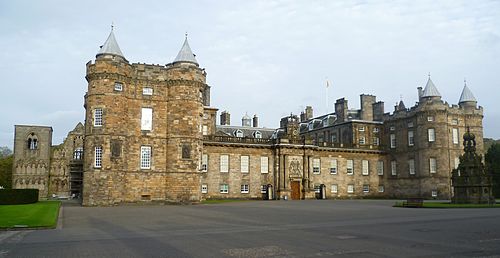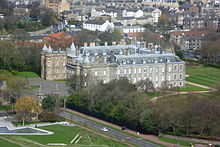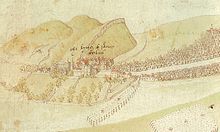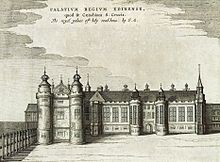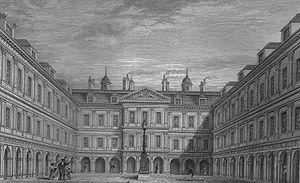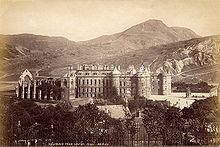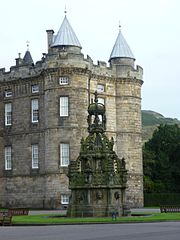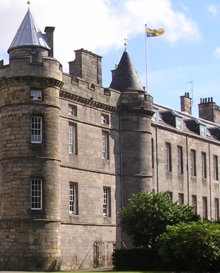- Holyrood Palace
-
The Palace of Holyroodhouse, commonly referred to as Holyrood Palace, is the official residence of the monarch in Scotland. The palace stands at the bottom of the Royal Mile in Edinburgh, at the opposite end to Edinburgh Castle. Holyrood Palace is the setting for state ceremonies and official entertaining.
Holyrood Abbey was founded by David I, King of Scots in 1128, and Holyrood Palace has served as the principal residence of the Kings and Queens of Scots since the 15th century. Queen Elizabeth II spends one week in residence at Holyrood Palace at the beginning of each summer, where she carries out a range of official engagements and ceremonies.
The palace is open to the public throughout the year, except when members of the Royal Family are in residence.
Contents
History
Holyrood Abbey
The ruined Augustinian abbey that is sited in the grounds was founded in 1128 at the order of King David I of Scotland. The name derives either from a legendary vision of the cross witnessed by David I, or from a relic of the True Cross known as the Holy Rood or Black Rood, and which had belonged to Queen Margaret, David's mother.[1] As a royal foundation, and sited close to Edinburgh Castle, it became an important administrative centre. A Papal legate was received here in 1177, while in 1189 a council of nobles met to discuss a ransom for the captive king, William the Lion.[2] Robert the Bruce held a parliament at the abbey in 1326, and by 1329 it may already have been in use as a royal residence. In 1370, David II became the first of several Kings of Scots to be buried at Holyrood. Not only was James II born at Holyrood in 1430, it was at Holyrood that he was crowned, married and laid to rest.[2] James III and Margaret of Denmark were married at Holyrood in 1469.[1] The early royal residence was in the abbey guesthouse, which most likely stood on the site of the present north range of the palace, west of the abbey cloister,[2] and by the later 15th century already had dedicated royal apartments.[1]
The early palace
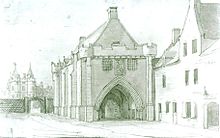 The gatehouse built by James IV, with the north-west tower of the palace behind, in a 1746 drawing by Thomas Sandby
The gatehouse built by James IV, with the north-west tower of the palace behind, in a 1746 drawing by Thomas Sandby
Between 1501 and 1505, James IV constructed a new palace adjacent to the abbey. The impetus for the work probably came from the marriage of James IV to Margaret Tudor, which took place in the abbey in August 1503 while work was still ongoing.[1] The palace was built around a quadrangle, situated west of the abbey cloister. It contained a chapel, gallery, royal apartments, and a great hall.[2] The chapel occupied the north range of the quadrangle, with the Queen's apartments occupying part of the south range. The west range contained the King's lodgings and the entrance to the palace. James IV also oversaw construction of a two-storey gatehouse, fragments of which survive in the Abbey Courthouse. In 1512 a lion house was constructed to house the king's menagerie, which included a lion and a civet among other exotic beasts.[3] James V added to the palace between 1528 and 1536, beginning with the present north-west tower to provide new royal apartments. This was followed by reconstruction of the south and west ranges, with a new chapel in the south. The former chapel in the north range was converted into a council chamber.[2] The west range contained a suite of rooms, extending the royal apartments in the tower.[4] The symmetrical composition of the west façade suggested that a second tower at the south-west was planned, though this was never executed at the time.[5]
In 1544, during the War of the Rough Wooing, the Earl of Hertford sacked Edinburgh, and Holyrood was looted and burned. Repairs were made, but the altars were destroyed by a Reforming mob in 1559.[4] After the Scottish Reformation was formalised, the abbey buildings were neglected, and the choir and transepts of the abbey church were pulled down in 1570. The nave was retained as the parish church of the Canongate.[4]
The rooms in the north-west tower of the palace were occupied by Mary, Queen of Scots, from her return to Scotland in 1561 to her forced abdication in 1567. She married both of her Scottish husbands in the palace: Henry Stewart, Lord Darnley, in 1565 in the chapel, and James Hepburn, 4th Earl of Bothwell, in 1567 in the great hall.[6] It was in her own apartments that she witnessed the murder of David Rizzio, her private secretary, on 9 March 1566. Darnley and others entered the Queen's apartment via the private stair from Darnley's own bedroom downstairs. Bursting in on the Queen and Rizzio, who were at supper, they dragged the Italian through the bedchamber into the outer chamber, where he was stabbed 56 times.[7]
James VI took up residence at Holyrood in 1579 at the age of 13 years. His wife, Anne of Denmark, was crowned in the diminished abbey church in 1590, at which time the royal household at the palace numbered around 600 persons.[6] When James became King of England in 1603 and moved to London, the palace was no longer the seat of a permanent royal court. James visited in 1617, for which the chapel was redecorated. More repairs were put in hand in preparation for the coronation of Charles I as King of Scotland at Holyrood in 1633.[4] On 10 August 1646 Charles appointed James Hamilton, 1st Duke of Hamilton, as hereditary Keeper of Holyroodhouse, an office which his descendants retain.[8]
In 1650, either by accident or design, the east range of the palace was set on fire during the visit of Oliver Cromwell and his soldiers. After this, the eastern parts of the palace were effectively abandoned. The remaining parts were used as barracks, and a two-storey block was added to the west range in 1659.
Rebuilding the palace
The following year saw the Restoration of Charles II in England and Scotland. The Privy Council was reconstituted and once more met at Holyrood. Repairs were put in hand to allow use of the building by the Earl of Lauderdale, the Secretary of State for Scotland, and a full survey was carried out in 1663 by John Mylne.[9] In 1670, £30,000 was set aside by the Privy Council for the rebuilding of Holyrood.[10]
Plans for complete reconstruction were drawn up by Sir William Bruce, the Surveyor of the King's Works, and Robert Mylne, the King's Master Mason. The design included a south-west tower to mirror the existing tower, a plan which had existed since at least Charles I's time. Following criticism from Charles II, Bruce redesigned the interior layout to provide suites of royal apartments on the first floor: the Queen's apartment on the west side; and the King's apartment on the south and east sides. The two were linked by a gallery to the north, and a council chamber occupied the south-west tower.[10]
Work began in July 1671, starting at the north-west, which was ready for use by Lauderdale the following year. In 1675 Lord Hatton became the first of many nobles to take up a grace-and-favour apartment in the palace. The following year the decision was taken to rebuild the west range of the palace, and to construct a kitchen block to the south-east of the quadrangle. Bruce's appointment as architect of the project was cancelled in 1678, with the remaining work being overseen by Hatton.[10] By 1679 the palace had been re-constructed, largely in its present form. Craftsmen employed included the Dutch carpenters Alexander Eizat and Jan van Santvoort, and their countryman Jacob de Wet who painted several ceilings. The elaborate plasterwork was done by John Houlbert and George Dunsterfield.[12]
Interior work was still in progress when the James, Duke of Albany, the future James VII and II, and his wife Mary of Modena visited that year.[13] They returned to live at Holyrood between 1680 and 1682, in the aftermath of the Exclusion crisis, which had severely impacted James' popularity in England. When he acceeded to the throne in 1685, the Catholic king set up a Jesuit college in the Chancellor's Lodging to the south of the palace. The abbey was adapted as a chapel for the Order of the Thistle in 1687-88. The architect was James Smith, and carvings were done by Grinling Gibbons and William Morgan. The interiors of this chapel, and the Jesuit college, were subsequently destroyed by an anti-Catholic mob, following the beginning of the Glorious Revolution in late 1688.[13] In 1691 the Kirk of the Canongate was completed, to replace the abbey as the local parish church, and it is at the Kirk of the Canongate that the Queen today attends services when in residence at Holyrood Palace.
18th-century decline
After the Union of Scotland and England in 1707 the palace lost its principal functions, although it was used for the elections of Scottish representative peers.[14] The nobles who had been granted apartments in the palace continued to use them: the Duke of Hamilton had already taken over the Queen's Apartments in 1684. The King's Apartments were meanwhile neglected.[13]
Bonnie Prince Charlie held court at Holyrood for five weeks in September and October 1745, during the Jacobite Rising. Charles occupied the Duke of Hamilton's apartments rather than the unkempt king's rooms, and held court in the Gallery. The following year, government troops were billeted in the palace after the Battle of Falkirk, when they damaged the royal portraits in the gallery, and the Duke of Cumberland stayed here on his way to Culloden.[15] Meanwhile the neglect continued: the roof of the abbey church collapsed in 1768, leaving it as it currently stands. However, the potential of the palace as a tourist attraction was already being recognised, with the Duke of Hamilton allowing paying guests to view Queen Mary's apartments in the north-west tower.[16]
The precincts of Holyrood Abbey, extending to the whole of Holyrood Park, had been designated as a debtor's sanctuary since the 16th century. Those in debt could escape their creditors, and imprisonment, by taking up residence within the sanctuary, and a small community grew up to the west of the palace. The residents, known colloquially as "Abbey Lairds", were able to leave the sanctuary on Sundays, when no arrests were permitted. The area was controlled by a baillie, and by several constables, appointed by the Keeper of Holyroodhouse. The constables now form a ceremonial guard at the palace.[17]
Revival of the palace
Following the French Revolution, George III allowed Louis XVI's youngest brother, the Comte d'Artois to live at Holyrood, where he took advantage of the abbey sanctuary to avoid his creditors. Artois stayed at Holyrood from 1796 to 1803, during which time the King's apartments were renovated. The Comte d'Artois inherited the French throne in 1824 as Charles X, but following the July Revolution of 1830, the French royals lived at Holyrood again until 1832 when they moved to Austria.[17]
King George IV became the first reigning monarch since Charles I to visit Holyrood, during his 1822 visit to Scotland. Although he stayed at Dalkeith Palace, the king held a levée (reception) at Holyrood, and was shown the historic apartments. He ordered repairs to the palace, but declared that Queen Mary's rooms should be protected from any future changes.[18] Over the next ten years, Robert Reid oversaw works including the demolition of all the buildings to the north and south of the main quadrangle, and remodelled the southern facade to match that of the east.[13] In 1834 William IV agreed that the High Commissioner to the General Assembly of the Church of Scotland could make use of the palace during the sitting of the assembly, and this tradition continues today.[13]
On the first visit of Queen Victoria to Scotland in 1842, she also stayed at Dalkeith, and was prevented from visiting Holyrood by an outbreak of Scarlet Fever.[19] In preparation for her 1850 visit, more renovations were carried out by Robert Matheson of the Office of Works, and the interiors were redecorated by David Ramsay Hay.[20] Over the next few years, the lodgings of the various nobles were gradually repossessed, and Victoria was able to take up a second floor apartment in 1871, freeing up the former royal apartments as dining and drawing rooms, as well as a throne room.[13] From 1854 the historic apartments in the north-west tower were formally opened to the public.[21] Meanwhile Prince Albert took an interest in the grounds, forming a new carriage drive to the north and laying out the garden in its present form.[22]
Although Edward VII visited briefly in 1903, it was George V who transformed Holyrood into a 20th-century palace. Central heating and electric light were installed prior to his first visit in 1911, and after the First World War improvements to bathrooms and kitchens were carried out. In the 1920s the palace was formally designated as the monarch's official residence in Scotland, and became the location for regular royal ceremonies and events.[23] Holyroodhouse remains the property of the Crown, and as one of the occupied royal residences is maintained by the Property Section of the Royal Household. Public access is managed by the Royal Collection Trust, with revenues used to support the work of the trust as custodians of the Royal Collection.[24]
Ghost
The naked ghost of one Bald Agnes (Agnes Sampson), stripped and tortured in 1592 after being accused of witchcraft, is said to roam the palace.[25]
Description
The palace as it stands today is largely the work of the late 17th-century. The exception is the 16th-century north-west tower, although the armorial panels on the walls are later replicas.[26] The rooms open to the public include the 17th-century former king's apartments and Great Gallery, and the 16th-century apartments in the north-west tower.
17th-century apartments
The Great Stair in the south-west corner of the quadrangle has a 17th-century Baroque ceiling featuring plaster angels holding the Honours of Scotland. The Italian paintings on the walls are fragments of frescoes painted circa 1550 by Lattanzio Gambara, illustrating scenes from Ovid's Metamorphoses. They were bought by Prince Albert in 1856, and placed here in 1881.[27] At the top of the stair is the Royal Dining Room, formerly part of the Queen's apartments. The Adam style decoration dates from around 1800, when this was part of the Duke of Hamilton's apartment.[28]
The King's apartments occupied the whole of the south and east sides of the quadrangle. Accessed from the Great Stair, the suite of rooms comprised a guard hall, presence chamber, privy chamber, antechamber, bedchamber and closet. The level of privacy, as well as the richness of decoration, increased in sequence. From the visit of George IV in 1822, the guard hall has been used as a throne room, and the order of rooms reversed. The Evening Drawing Room and Morning Drawing Room occupy the former presence chamber and privy chamber, and retain their rich 17th-century ceilings. The Morning Drawing Room is hung with French tapestries bought by Charles II, and is used for private cenremonies.[29] The King's Antechamber, Bedchamber and Closet are laid out along the east side of the palace. The King's Bedchamber, at the centre of the east façade, has the finest of the 17th-century plaster ceilings, augmented by paintings of Hercules by Jacob de Wet (II). The 17th-century bed was made for the Duke of Hamilton, although it was long referred to as "Queen Mary's Bed" when it occupied the older Queen's rooms.[30]
The Great Gallery, the largest room in the palace, links the King's Closet with the former Queen's apartments in the west range. The gallery is decorated with 110 portraits of the Scottish monarchs, beginning with the legendary Fergus I, who supposedly ruled from 330 BC. The portraits were all completed between 1684 and 1686 by Jacob de Wet. After 1707, Scotland's representative peers were elected here to be sent to Westminster. Bonnie Prince Charlie held evening balls in the gallery during his brief occupation, and it later became a Catholic chapel for the Comte d'Artois. Today it is used for large functions including investitures and banquets.[31]
North-west tower
The suite of rooms on the first floor of the north-west tower comprises an audience chamber, accessed from a lobby next to the Great Gallery, and a bedroom, leading from which are two turret rooms or closets. These rooms were occupied by Lord Darnley in the 17th century, and later formed part of the Queen's apartment in the reconstructed palace, before being taken over by the Duke of Hamilton from 1684.[32] Queen Mary occupied an identical suite of rooms on the second floor of the tower: the bedchambers are linked by a private spiral stair. The Queen's outer chamber contains her oratory, and was the scene of the murder of David Rizzio, after he was dragged from the supper table in the northern turret room.[33] In later centuries, tourists were often convinced that they could see his blood stains on the floor.
The wooden ceilings of both the main rooms date from Queen Mary's time, and the monograms MR (Maria Regina) and IR (Jacobus Rex) refer to Mary and her son, James VI. Shields commemorating Mary's marriage to Francis II of France are believed to have been carved in 1559 but put in their present position in 1617, when the grisaille frieze was also added.[34]
Gardens and grounds
The gardens of the palace extend to some 10 acres (4.0 ha), set within the much larger Holyrood Park. In the 16th century a privy garden was located to the north of the palace, accessed via a wooden gallery from the north-west tower. This was removed in the 19th century when the present carriage drive was formed to avoid the Canongate slums. A small garden building survives from this time, and is known as Queen Mary's Bath House although it is not thought to have been used for bathing.[35] The sundial to the north of the palace was carved in 1633 by John Mylne,[35] while the fountain in the forecourt is a 19th-century replica of the 16th-century fountain at Linlithgow Palace.[36] The ironwork gates and screens were erected in the 1920s, along with a statue of Edward VII, unveiled by George V in 1922.[37]
The buildings to the west of the palace, through which the public enter, comprise the 19th-century guardhouse which replaced the tenements of the debtor's sanctuary. Adjacent to this is the Queen's Gallery, opened in 2002 to display works of art from the Royal Collection.
Big Royal Dig
The Palace of Holyroodhouse, along with Buckingham Palace Garden and Windsor Castle, was excavated on 25–28 August 2006 as part of a special edition of Channel 4's archaeology series Time Team. Timed to coincide with the 80th birthday of Queen Elizabeth II, this marked the 150th dig conducted by Time Team, and presented a rare opportunity for trenches to be dug within the royal gardens.[38]
The archaeologists uncovered part of the cloister of Holyrood Abbey, running in line with the existing abbey ruins, and a square tower associated with the 15th-century building works of James IV was discovered. The team failed to locate evidence of the real tennis court used by Queen Mary to the north of the palace, as the area had been built over in the 19th century. An area of reddened earth was discovered, which was linked with the Earl of Hertford's burning of Holyrood during the Rough Wooing of 1544. Among the objects found were a seal matrix used to stamp the wax seal on correspondence or documents,[39] and a French double tournois coin, minted by Gaston d'Orleans in 1634.[40]
Official role
Holyroodhouse with the Queen in residence, signified by the flying of the Royal Standard of the United Kingdom (for use in Scotland)
In modern times, monarchs have spent at least one week every year formally holding court in the palace. The present Queen spends one week at Holyrood in summer, during which time investitures are held in the gallery, audiences are held in the morning room, and garden parties are hosted.[41] While she is in residence, the Scottish variant of the Royal Standard of the United Kingdom is flown; at all other times the Royal Standard of Scotland is displayed.[41] During the Queen's visits, the Royal Company of Archers form her ceremonial bodyguard. The Ceremony of the Keys, in which she is formally presented with the keys of Edinburgh by the Lord Provost, is held on her arrival.[36] At the Palace the Queen meets and appoints the First Minister of Scotland. Prince Charles also stays at Holyrood for one week a year, carrying out official duties as the Duke of Rothesay,[41] while other members of the royal family, including Princess Anne, visit in a less official capacity.
In its role as the official residence of the monarch in Scotland, Holyroodhouse has hosted a number of foreign visitors and dignitaries, including Harald V of Norway in 1994,[citation needed] Margrethe II of Denmark,[citation needed] François Mitterrand,[citation needed] Helmut Kohl,[citation needed] Nelson Mandela,[citation needed] Vladimir Putin in 2003,[42] and Pope Benedict XVI in 2010.[43] A meeting of the European Council was held at the palace during the British presidency of the council in 1992.[44]
Architectural historian Dan Cruickshank selected the Palace as one of his eight choices for the 2002 BBC book The Story of Britain's Best Buildings.[45]
The Keeper of Holyroodhouse
A measure of the importance of Holyroodhouse is the status of its Keeper, who was appointed to oversee the Palace in the absence of the court. There were various grants of the office of Keeper of Holyroodhouse until 1646 when King Charles I conferred it heritably on the 1st Duke of Hamilton, whose descendants have retained it ever since. The post is one of the Great Offices in the Royal Household in Scotland, and indeed the private ducal apartments cover a larger area of the palace than the state ones. As well as his own deputy, the Keeper still appoints the Bailie of Holyroodhouse, who is responsible for law and order within the Holyrood Abbey Sanctuary. The High Constables of Holyroodhouse are responsible to the Keeper.
There was formerly a separate Keeper of Holyrood Park, which surrounds Holyroodhouse, and the title was held on an hereditary basis by the Earls of Haddington. This was purchased by the Crown and the office extinguished in 1843 after disputes over the Keeper's right to allow quarrying within the Park.
See also
- Holyrood (disambiguation)
- Historic Scotland (Executive agency of the Scottish Government responsible for Holyrood Abbey).
References
- ^ a b c d Clarke, p.8
- ^ a b c d e McWilliam et al. p.125
- ^ Clarke, p.9
- ^ a b c d McWilliam et al. p.126
- ^ Clarke, p.10
- ^ a b Clarke, p.12
- ^ Clarke, p.56
- ^ Clarke, p.17
- ^ Clarke, p.14
- ^ a b c McWilliam et al. p.127
- ^ Daniel, William S. (1852), History of the Abbey and Palace of Holyrood. Edinburgh : Duncan Anderson. facing p. 139
- ^ Clarke, p.16
- ^ a b c d e f McWilliam et. al. p.128
- ^ Clarke, p.49
- ^ Clarke, pp.17–19
- ^ Clarke, pp.19–20
- ^ a b Clarke, p.20
- ^ Clarke, p.22
- ^ Clarke, p.23
- ^ Clarke, p.24
- ^ Clarke, p.26
- ^ Clarke, p.64
- ^ Clarke, pp.27–28
- ^ "Organisation of the Royal Collection: Management". THe Royal Collection. http://www.royalcollection.org.uk/default.asp?action=article&ID=13. Retrieved 2011-05-20.
- ^ Why you've more than a ghost of a chance of seeing a spook - Scotsman.com News
- ^ Clarke, p.32
- ^ Clarke, p.33
- ^ Clarke, p.36
- ^ Clarke, pp.39–43
- ^ Clarke, pp.43–45
- ^ Clarke, pp.49–50
- ^ Clarke, pp.51–52
- ^ Clarke, pp.56–58
- ^ Clarke, pp.55
- ^ a b Clarke, pp.63–64
- ^ a b Clarke, p.30
- ^ Clarke, p.28
- ^ "Digging at the Palace". Time Team Big Royal Dig. Channel 4. Archived from the original on 2008-06-20. http://replay.web.archive.org/20080620001104/http://www.channel4.com/history/microsites/B/big_royal_dig/digs.html. Retrieved 2011-05-02.
- ^ "Seal Matrix". Time Team Big Royal Dig. Channel 4. Archived from the original on 2008-06-20. http://replay.web.archive.org/20080620001104/http://www.channel4.com/history/microsites/B/big_royal_dig/holy/finds/holy_finds1.html. Retrieved 2011-05-02.
- ^ "Double Tournois". Time Team Big Royal Dig. Channel 4. Archived from the original on 2008-06-20. http://replay.web.archive.org/20080620001104/http://www.channel4.com/history/microsites/B/big_royal_dig/holy/finds/gallery_14_holy_finds1.html. Retrieved 2011-05-02.
- ^ a b c Clarke, p.4
- ^ Clarke, p.5
- ^ "Pope Benedict XVI's speech at Holyrood Palace". The Scotsman. 2010-09-16. http://news.scotsman.com/edinburgh/Full-text-Pope-Benedict-XVI39s.6535661.jp. Retrieved 2011-05-20.
- ^ "1992 Conservative Party General Election Manifesto". The Conservative Party. http://www.conservative-party.net/manifestos/1992/1992-conservative-manifesto.shtml. Retrieved 2011-05-20.
- ^ Cruickshank, Dan. "Choosing Britain's Best Buildings". BBC History. http://www.bbc.co.uk/history/programmes/programme_archive/best_buildings_07.shtml. Retrieved 3 June 2008.
Bibliography
- Clarke, Deborah (2010). The Palace of Holyroodhouse: Official Souvenir Guide. Royal Collection Publications. ISBN 9781905686018.
- Dunbar, John (1999). Scottish Royal Palaces. Tuckwell Press. ISBN 186232042X.
- Gallagher, Dennis (1998). "Holyrood Abbey: the disappearance of a monastery". Proceedings of the Society of Antiquaries of Scotland 128: 1079–1099. http://ads.ahds.ac.uk/catalogue/adsdata/arch-352-1/dissemination/pdf/vol_128/128_1079_1099.pdf.
- Jamieson, Fiona (Summer 1994). "The Royal Gardens of the Palace of Holyroodhouse, 1500-1603". Garden History 22 (1): 18–36. JSTOR 1587000. (JSTOR subscription required)
- Laing, Henry (1867). "Queen Mary's Audience Chamber at Holyroodhouse". Proceedings of the Society of Antiquaries of Scotland 7: 381–384. http://ads.ahds.ac.uk/catalogue/adsdata/arch-352-1/dissemination/pdf/vol_007/7_381_387.pdf.
- McWilliam, Colin; Gifford, John; Walker, David (1984). Edinburgh. The Buildings of Scotland. Penguin. ISBN 014071068.
External links
- Palace of Holyroodhouse, The Royal Collection website
- The Royal Residences: Palace of Holyroodhouse, official website of the British Monarchy
Coordinates: 55°57′09″N 3°10′21″W / 55.9525°N 3.1725°W
Categories:- Buildings and structures completed in 1679
- Category A listed buildings in Scotland
- History of Edinburgh
- Inventory of Gardens and Designed Landscapes
- Listed buildings in Edinburgh
- Palaces in Scotland
- Royal Mile
- Royal residences in Scotland
- Royal residences in the United Kingdom
- Scheduled Ancient Monuments in Scotland
- Visitor attractions in Edinburgh
- William Bruce buildings
- Gardens in Edinburgh
- Historic house museums in Edinburgh
- Country houses in Scotland
- Reportedly haunted locations in Scotland
Wikimedia Foundation. 2010.

